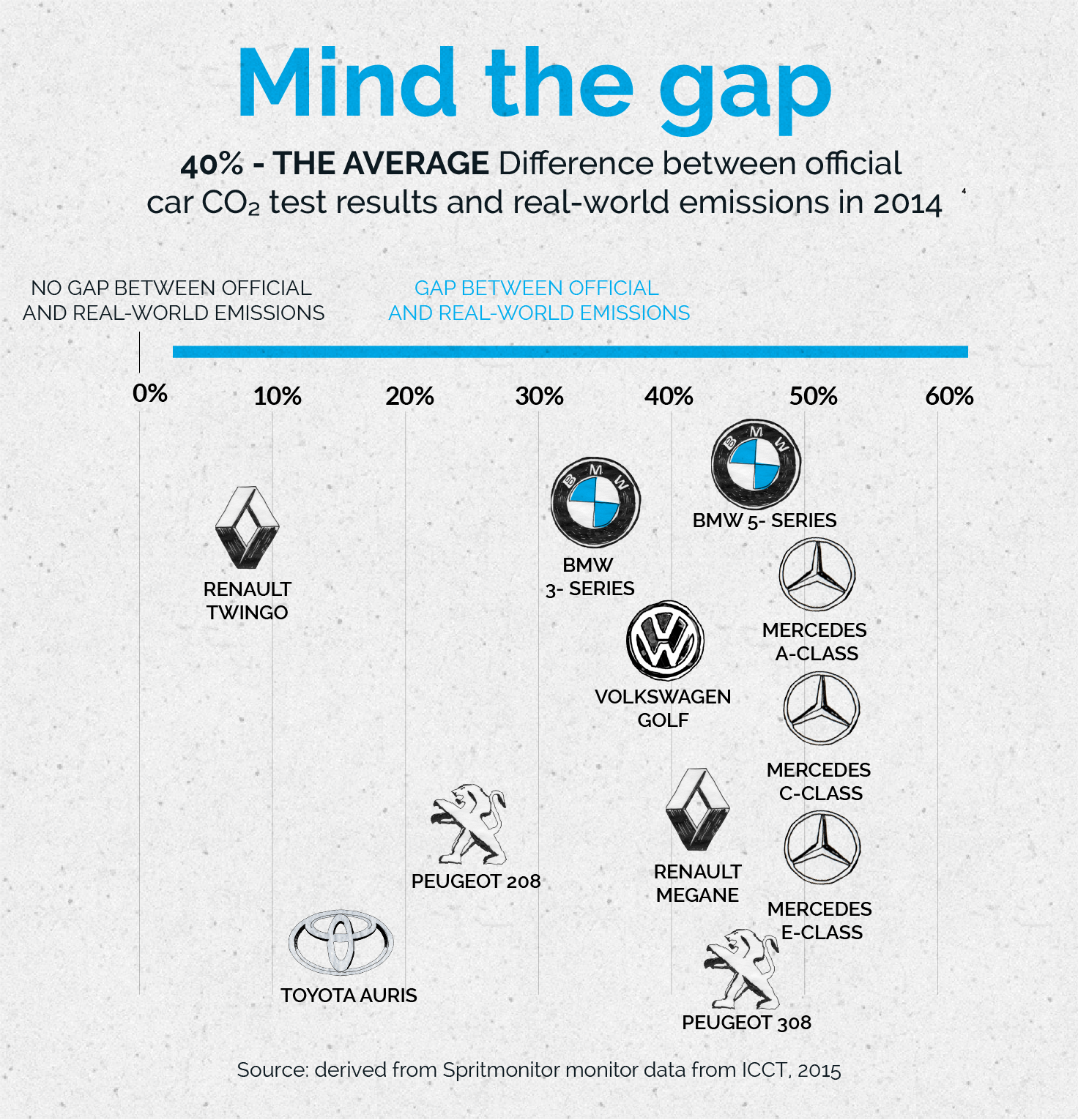Dieselgate: exposing the tip of the iceberg – and what lies beneath
Late one Friday evening last September, T&E started receiving emails and calls from startled automotive journalists. Volkswagen, the talisman of German industrial prestige and Europe’s leading carmaker, had been caught cheating emissions tests in the US. On-board software detected when its vehicle emissions were measured in a lab and adjusted its performance to defeat the test. Its diesel cars were in fact emitting 35 to 40 times US regulatory levels, triggering a recall of 482,000 vehicles and a potential fine of $18 billion.
It was possibly the biggest scandal in carmaking history and T&E were the go-to organisation for media seeking an explanation. T&E had dried out the forest for years with reports showing carmakers cheating or manipulating tests for air pollution and carbon emissions. (Our first study on the topic, Cycle Beating and the EU test cycle for cars, had been published in 1998.) And VW’s snaring and admission was the spark that lit the fire. The resulting wildfire is still burning – with far-reaching consequences for how national authorities test cars and who has oversight. But just four days before the VW scandal exploded, T&E’s Don’t Breathe Here! report had pointed the finger at several carmakers.

The Don’t Breathe Here! report’s compelling evidence that VW was just the tip of the iceberg was dynamite. It showed on average new diesel cars produced emissions about five times higher than the allowed limit, and just one in 10 of the cars tested complied with the law. It showed Europe’s testing system is obsolete, allowing carmakers to use cheaper, less effective exhaust treatment systems in cars sold here. In the week of #VWgate (later to be #dieselgate), the contrast with the tough US regulations was humiliating for the EU.
A week later T&E delivered a second hammer blow with publication of its annual Mind the Gap report, showing a chasm between official and real-world fuel consumption. New cars, including the Mercedes A, C and E class, BMW 5 series and Peugeot 308, were now swallowing around 50% more fuel than their lab test results. The chasm was so wide – 40% on average – that it could no longer be explained just through test manipulations such as fully charging the battery and taping over grills. The possibility of a software ‘defeat device’, similar to that used by VW, could no longer be ruled out.

With two-thirds of the claimed gains in CO2 emissions and fuel consumption since 2008 actually having been delivered through manipulating or cheating tests, the case for a rapid overhaul of the EU testing system could no longer be ignored. By year’s end, Industry Commissioner Elżbieta Bieńkowska gave in to the inevitable and admitted the EU type approval system had failed. She promised more EU oversight and the possibility of sanctions for national authorities not doing their jobs. The announcement came following a further shameful admission by VW (this time that they had produced misleading fuel efficiency figures) and a raft of tests exposing dodgy practices by other carmakers.
The European Commission, at the bidding of Germany among others, gifted carmakers a disgraceful deal to double and delay nitrogen oxide (NOx) limits for new diesel cars and vans. It would permit dirty diesels to continue causing premature deaths, asthma and birth abnormalities under even looser pollution limits. T&E exposed the hypocrisy of governments publicly talking tough on air pollution but privately lobbying for weaker NOx limits, and the European Parliament came close to rejecting the dodgy deal that had been struck behind closed doors during a ‘comitology’ process. The new limits are almost certainly illegal and may yet be overturned by the European court. The battle continues.
 “According to Transport & Environment (T&E), a green pressure group, the gulf between stated fuel-economy figures (and by extension carbon-dioxide emissions) and those achieved by an average driver has grown to 40% in recent years”
“According to Transport & Environment (T&E), a green pressure group, the gulf between stated fuel-economy figures (and by extension carbon-dioxide emissions) and those achieved by an average driver has grown to 40% in recent years”
The Economist, 26 September 2015
Meanwhile, T&E’s long campaign to replace the obsolete test for car CO2, the NEDC, was bearing fruit. The WLTP, the new test, is scheduled to come into force in 2017 and will close the loopholes that we demonstrated carmakers abuse to produce better fuel consumption ratings. In preparing for its introduction, carmakers have denied they gamed the system and since sought credits for their cheating – in order to relax the 2021 car target of 95g of CO2 per km when the new WLTP test is introduced. As a result, we could go from having a good standard under a weak test to a weak standard under a better test. T&E exposed the collusion by some member states to effectively weaken CO2 standards behind closed doors, and will continue to do so in 2016.
 “Da besteht ganz offensichtlich ein Unterschied zwischen dem was Politiker in Deutschland sagen und dem was sie in Buessel tun. Sie fuehren die Oeffentlichkeit in die Irre, wenn sie sich im gleichen Atemzug einerseits fuer bessere Tests einsetzen aber gleichzeitig durchs Hintertuerchen mit Schlupfloechern torpedieren – das ist Heuchelei!”
“Da besteht ganz offensichtlich ein Unterschied zwischen dem was Politiker in Deutschland sagen und dem was sie in Buessel tun. Sie fuehren die Oeffentlichkeit in die Irre, wenn sie sich im gleichen Atemzug einerseits fuer bessere Tests einsetzen aber gleichzeitig durchs Hintertuerchen mit Schlupfloechern torpedieren – das ist Heuchelei!”
– Greg Archer, clean vehicles director
Panorama, TV ARD 1, 26 November 2015, prime time
An on-road CO2 test is the ultimate goal of T&E and strides towards this were made when PSA Peugeot Citroen asked for help measuring and publicising their real-world emissions. With T&E’s collaboration to devise the methodology, PSA become the first carmaker to accept that real-world tests for CO2 are possible – breaking an industry shibboleth. The company will also collaborate to measure pollutant levels, including NOx, as a second step.
But 2015 was also the end of the road for T&E’s annual How clean are Europe’s cars report. After 10 years, the official figures on carmakers’ progress towards the EU’s CO2 targets are obsolete – the gap between the reported data and reality is now too glaringly obvious. And so the 10th edition is the final one – until credibility has been restored, at least.
Learn more
http://www.transportenvironment.org/what-we-do/cars-and-CO2








